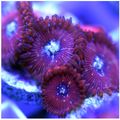Difference between revisions of "Palythoa"
From The Aquarium Wiki
PsiPro bot (talk | contribs) m (→Alternative names: clean up) |
|||
| Line 39: | Line 39: | ||
== Pictures == | == Pictures == | ||
| + | <gallery> | ||
| + | Image:Palythoa Red.jpg | ||
| + | </gallery> | ||
== External links == | == External links == | ||
| + | *[http://aquariumdepot.com/corals/soft-coral/palythoas Aquarium Depot] | ||
[[Category:Coral (Saltwater)]] | [[Category:Coral (Saltwater)]] | ||
[[Category:Coral (Soft Corals)]] | [[Category:Coral (Soft Corals)]] | ||
Revision as of 18:08, 6 July 2018
| You can contribute to the Aquarium Wiki by expanding this article. Dont be shy!. |
Contents
Alternative names
- Button Polyps, Palys.
Tank compatibility
- May sting neighbouring coral. Realeases toxic poision if cut.
Diet
- Palythoa contain a symbiotic algae called zooxanthellae and are therefore photosynthetic. They will benefit, however, from occasional feedings of microplankton.
Feeding regime
- Only occasional feedings are necessary as they are photosynthetic corals.
Environment Specifics
- Is sold as a "frag" that is easily placed into the tank. Provide it with space to grow as it may sting neighbouring coral. Their placement should be planned carefully. Needs a moderate flow to move water with poisons away to be cleaned out of the water. Palythoa or "Palys" will live under a varity of lighting conditions, however, for their colors to remain bright and vivid they should be placed in a region of 200 to 400 PAR.
Behaviour
- Poisonous, ALWAYS wear gloves when handling this coral. Poly-toxin is one of the most poisionus substances known to man, not all palys have it but you don't want to find out the hard way.
Identification
- An attractive and popular colourful colony coral. They are available in a variety of colours including green, tan, pink, brown and orange. Palys are a close reletive to Zoanthus, and thus are often mistaken for them. Two things differentiate them from one another. One being that Palys will take up peices of sand and substrate into their base to make their mat tougher, and two their oral disk is generally larger with a small slit in the center.

